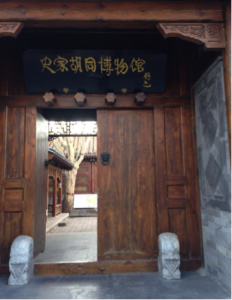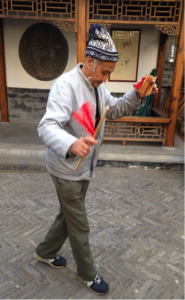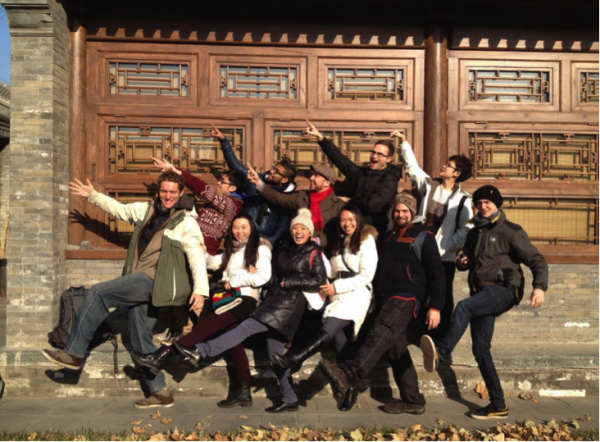史家胡同博物馆:那些年的记忆和声音
Shijia Hutong Museum: Sound and Memory
by Julie Zou, Education Programs Coordinator
自从我通过了导游资格考试,公司的同事都拿我打趣,要我组织大家一起出去玩儿,且要求专业讲解。说实话,公司的外国同事大多是中国通,公司的中国同事居住在北京的时间比我还久,若是真的带他们出去玩儿,我只能是班门弄斧。我一直想着有一天,我要找到一些小众的但独具特色的地方来介绍给大家。谁知,这事儿竟被我的外国同事Jeffrey抢了先。
Ever since I passed the examination to be a tour guide, my co-workers have been teasing me that I should organize a trip for everyone to go somewhere which requires a real professional to explain. Honestly, most of my foreign colleagues could be considered “Zhongguo Tong” and many have lived here a long time. I’d feel a little foolish trying to parade my skills in front of them, like the man who showed off his skills with a hatchet in front of the famous carpenter Lu Ban. I thought one day I could find some hidden nook to show off but even then…my American colleague Jeffrey beat me to it!
Jeffrey对中国历史特别感兴趣,而且对文化遗产保护有深入研究。这次他就提议大家一起去参观史家胡同博物馆。我们公司的就位于四合院,所以我觉得参观胡同博物馆是多此一举。但是鉴于Jeffrey的强烈推荐,我就告诉自己,去吧,说不定有惊喜呢。
Jeffrey is especially interested in Chinese history and has done a lot of research into Beijing’s cultural heritage and cultural preservation. Last month, he suggested we visit Shijia Hutong. Our company is also located in an old hutong courtyard, so I didn’t quite get why we were going to another hutong to visit a museum that was based in an old courtyard. But Jeff strongly recommended we go and so I told myself maybe I was in for a surprise.
公司愿意参加这次活动的人约好早上9:30一起在史家胡同博物馆门前集合。我从灯市口地铁站A口出来以后,往东北方向走。博物馆位于史家胡同24号。一路走过来经过了史家小学,中国妇联出版社,其中还经过了红墙史家花园酒店。终于到了24号,首先印入眼帘的是古朴的棕色木门,灰墙灰瓦,白色大理石的门墩,门楣是由舒乙先生题写的馆名。仅仅是这扇门便已深深地吸引了我。
At 9:30 that morning, the staff of our company met in front of the Shijia Hutong Museum. I exited from Dengshikou Subway and walked northeast a bit to reach the museum, which is located at Number 24 Shijia Hutong. To get there, you pass the Shijia Hutong Primary School, the China Women’s Federation Publishing House, and the red walls of the Shijia Huayuan Hotel. When you finally reach Number 24, the first impression is the brown, rustic wooden doors, the gray walls and tiles, and the white marble door markers, each inscribed by Mr. Shu Yi. Even though I had only arrived at the front door, I was already intrigued.

这个博物馆是免费参观的,所以完全没有买票的程序。过了一会,同事们陆续来了。我们就直接进去了。Jeffrey已经来过这里好几次了,所以他认识这里的工作人员。在我们还没有开始参观时,一位师傅就和Jeffrey聊起来。这位师傅姓杨,一口重重的北京味儿。他介绍自己是老北京吆喝非遗挖掘小分队的老吆喝迷。我们完全不知道这是什么样的角色。他就拿出快板,给我们吆喝上了。记忆最深的一段儿是在市场的卖鱼吆喝。欣赏这位师傅浓重的老北京的表演,完全是计划之外的收获。
The museum is free to visit, so there was no need to buy a ticket. After a short while, my colleagues arrived and we went inside. Jeffrey had been there several times and already knew many of the staff. We hadn’t been there for very long when an older gentleman named Mr. Yang began chatting with Jeffrey. Mr. Yang was as Beijing as they come. He introduced himself as a member of a group dedicated to preserving the sounds of Beijing’s street peddlars. We asked him what that meant and he took out an old clapper and gave a great shout. It reminded many of us of the vendors in the market selling fish. Those vendors would give great shouts to alert customers to their sales and wares. This incredible performance of the sounds of old Beijing was not even part of our plan. It was just an incredible coincidence that Mr. Yang was there the morning we visited.
 这个博物馆是个一进两重的四合院,该院落在民国时期是凌叔华的祖宅。该四合院被改建为社区博物馆,得益于英国王储慈善基金的捐赠。虽然是个小博物馆,但是馆内可看之处却不少。馆内设有史家历史展厅(介绍史家胡同的历史),人艺展厅(北京艺术剧院曾经也位于史家胡同),近代教育展厅(此四合院曾经是史家胡同小学),陈西滢及凌叔华纪念展厅,胡同名人展厅,时代记忆展厅。在这几个展厅中,我最为感兴趣的是史家历史展厅和陈西滢及凌叔华纪念展厅。
这个博物馆是个一进两重的四合院,该院落在民国时期是凌叔华的祖宅。该四合院被改建为社区博物馆,得益于英国王储慈善基金的捐赠。虽然是个小博物馆,但是馆内可看之处却不少。馆内设有史家历史展厅(介绍史家胡同的历史),人艺展厅(北京艺术剧院曾经也位于史家胡同),近代教育展厅(此四合院曾经是史家胡同小学),陈西滢及凌叔华纪念展厅,胡同名人展厅,时代记忆展厅。在这几个展厅中,我最为感兴趣的是史家历史展厅和陈西滢及凌叔华纪念展厅。
The museum occupies a double courtyard. During the Repulican era, it was the home of Ling Shuhua. Since then, the courtyard has been converted into a community museum thanks to donations from the Prince’s Foundation. Although the museum is not large, there is still a lot to see. The museum features the historical layout of Shijia Hutong and introduces the history of the area. There is also an exhibition room dedicated to the People’s Art Theater, which was once located on Shijia Hutong, as well as an education hall, a remnant of the days when the courtyard was occupied by the local primary school. I found most interesting the memorial hall for Ling Shuhua and Chen Xiying, two famous residents of Shijia Hutong.
北京的胡同在多重挤压下,正在不可挽救地消亡。以前我看到有关胡同的介绍书籍,都是空洞的概念。对于胡同内四合院一进、两进的算法总是迷迷糊糊。那些有关垂花门、倒座门的叙述也只能凭空想象。网上图片倒是不少,不过难以给人深刻的印象。在这个胡同博物馆里,我终于有幸目睹了胡同模型。史家胡同的模型不仅是复原了当时凌叔华祖宅的面貌,还复原了史家胡同130个院落。站在这些院落微缩复原模型前,50多年前的历史风貌也不再遥远。
The hutongs of Beijing are in serious danger of being crowded out of existence by the rapid development of the city around them. Before, when I read about this in books, this process was an abstract concept, devoid of real meaning. I was always confused about those courtyards with multiple sections behind their walls. What these homes looked like could only be imagined. There are many pictures online, but it’s hard to get a real impression from photographs. At the museum, I finally had the opportunity to see models of the hutong, not only the ancestral home of Ling Shuhua but also 130 other courtyards along Shijia Hutong. Standing in front of the model of all of these courtyards in miniature, the historical character of the neighborhood didn’t feel so far away.
此外,这个博物馆还是一个领略民国时代名人风范的场地。凌叔华既是女作家,又是画家,还是被徐志摩誉为“中国的曼殊菲尔”的大美女 。她与著名文人陈西滢结婚后,这个院子便成了北京名流汇集的“小姐家的大书房”,与林徽因“太太的客厅”齐名, 辜鸿铭、陈寅恪、齐白石、巴金、徐志摩、沈从文还有印度诗人泰戈尔,都曾是24号院的常客。民国时代的文人互相交好实属罕见。自古文人相亲,在这个“小姐家的大书房”倒并没有发生。
Additionally, the museum recreates an air of Republican-era style. Ling Shuhua was both a writer and painter, referred to by the great poet Xu Zhimo as a great beauty and “China’s (Katherine) Mansfield.” After she married the famous scholar Chen Xiying, their yard became a great salon for Beijing’s literary elite. Lin Huiyin, Gu Hongming, Chen Yinke, Qi Baishi, Ba Jin, Xu Zhimo, and Shen Congwen all were regulars and even the great Indian Poet Rabindranath Tagore spent time at Number 24. Such a collection of Republican-era literati is rare indeed. Since ancient times, literati were often on intimate terms with each other. In modern times, this did not happen until the salon at number 24.
每个人游览博物馆时都有不同的兴趣点。在这个博物馆里,对大多数人来说,最吸引人的地方是时代记忆展厅。在这个展厅内一个特殊的房间内布置了专业的音响设备,只要点击触摸屏,就能够听到不同的“胡同声音”。这里一共收录了大约70种胡同声音。当时Jeffery强烈推荐这个博物馆就曾提到这些“胡同声音”的存在。当然从Jeffrey个人角度来看,他最喜欢的部分是博物馆进门左手边的那面墙。那面墙还保留着此处作为史家胡同小学时孩子们的涂鸦。Jeffrey认为这些原始遗迹才是最能呈现历史的方式。
 Everyone had their own favorite parts of the museum. For most people, the most interesting part was the “Memory Room.” This room is furnished with audio equipment and visitor can tap a touch screen to hear the sounds of the hutong from different eras. There over 70 different soundscapes. Jeffrey highly recommended this room to us but in fact, Jeffrey’s favorite part is the wall just to the left of the museum door where there still remains a bit of graffiti left over from the school children who once studied in the courtyard. For Jeffrey, this is where the most authentic relics of history remain.
Everyone had their own favorite parts of the museum. For most people, the most interesting part was the “Memory Room.” This room is furnished with audio equipment and visitor can tap a touch screen to hear the sounds of the hutong from different eras. There over 70 different soundscapes. Jeffrey highly recommended this room to us but in fact, Jeffrey’s favorite part is the wall just to the left of the museum door where there still remains a bit of graffiti left over from the school children who once studied in the courtyard. For Jeffrey, this is where the most authentic relics of history remain.
整个参观过程只有一个半小时,对我来说,太短暂。可是大家下午都还有别的事儿,也就不能在此游览一整天。在工作日大家一起出来参观博物馆,大约也只有我们胡同员工可以享受这般待遇了。我觉得很不尽兴,希望下次继续再去。当然,在离去之前,我们不可免俗地一起拍了照片,证明我们到此一游。
For me, a 90-minute visit was too short but we have things to do back in the office in the afternoon and we can’t spend the whole day at the museum. But taking some time to visit the museum on a working day was fun for our staff. It was fun for me too, and I can’t wait for our next trip. But of course…what would it be without a photo to prove we were there?
地址: 北京市东城区朝阳门街道史家胡同24号
开放时间: 9:30 – 16:30 (周二至周日)
Shijia Hutong Museum
Beijing Dongcheng District, Chaoyangmen Street, Shijia Hutong, #24
Open every day (except Tuesdays) from 9:30-4:30.











